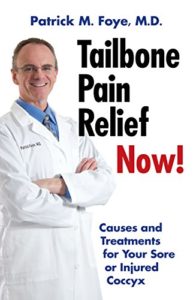As a proud, self-proclaimed PT nerd/lifelong learner, one of my favorite genres of books are those that pertain to medicine and physical therapy. (Pretty sure my patients prefer that over Twilight, said with all due respect to Stephanie Meyer.) Whenever I read a truly excellent and informative book, I enjoy sharing what I have learned with my readers.
On that note, allow me to introduce you to “Tailbone Pain Relief Now!” by Dr. Patrick Foye, a physician who specializes in pain management and physical medicine and rehabilitation. He is the founder and director of the Coccyx Pain Center (Tailbone Pain Center) in Newark, NJ.
Some of the key highlights of Dr. Foye’s book are as follows:
- The coccyx (tailbone) is comprised of 3-5 bones that are fused together, and it is not one single bone. The natural variance between individuals can confuse medical care providers when reading diagnostic imaging
- Dynamic instability of the coccyx occurs much more frequently than fracture. In fact, Dr. Foye estimates that he diagnoses instability twenty times more often than fractures
- Jean-Yves Maigne discovered the importance of performing coccyx x-rays in both the sitting and standing positions. This is because there can be up to a 20-degree difference in the coccyx’s position in sitting vs. standing, and it is therefore important to assess the coccyx’s location in both of these positions for a complete and clear picture
- When the coccyx dislocates anteriorly, or forward (increased flexion), it can create pain during defecation and/or childbirth, and when the coccyx dislocates posteriorly, or backward (increased extension), there will likely be increased pain during sitting (where there is increased weight bearing onto the coccyx)
- Pain is exacerbated during sitting with an extended coccyx. Therefore, many people will compensate by sitting with increased forward flexion or increased weight bearing onto one of the buttocks to shift weight off the tailbone in order to alleviate the pain. This can alter musculoskeletal alignment (ex. shortening of hip flexors or of the piriformis muscles) and create pain in other local structures
- Dr. Foye discusses two different types of injections for coccyx and associated pain:
- Local anti-inflammatory steroid injections can be helpful for treating musculoskeletal related inflammation. It may require anywhere between two days and two weeks to notice improvements after these injections
- Ganglion Impar sympathetic nerve blocks are local anesthetics injected around nerves to help decrease sympathetically maintained pain, or pain that is interpreted by the brain due to upregulation of the central nervous system. (The same stimulus that is perceived as non-painful in an individual without sympathetically maintained pain will be perceived as noxious and painful in an individual with this condition.)
- Both injections should be performed under guided fluoroscopy, not blindly, to ensure accuracy
- Anecdotally, Dr. Foye has found wedge cushions to be superior to donut or ring cushions.
I encourage anyone who has been experiencing tailbone pain to perform extensive research before selecting a doctor. Many well-meaning doctors are clueless when it comes to the coccyx, and it is important to select a medical care provider who is well versed in this specialty. Dr. Foye suggests calling potential providers and asking them what percentage of their patients are being treated for coccyx pain and does this office perform ganglion impar nerve blocks. If they don’t know what the word coccyx means or have never heard of that procedure, chances are they are not the best option.
Pelvic floor physical therapists are equipped to treat the musculoskeletal component of coccyx pain. If you or someone you know stands to benefit from these services, please contact us at Revitalize Physical Therapy. It would be an honor and privilege to help you along your healing journey!




